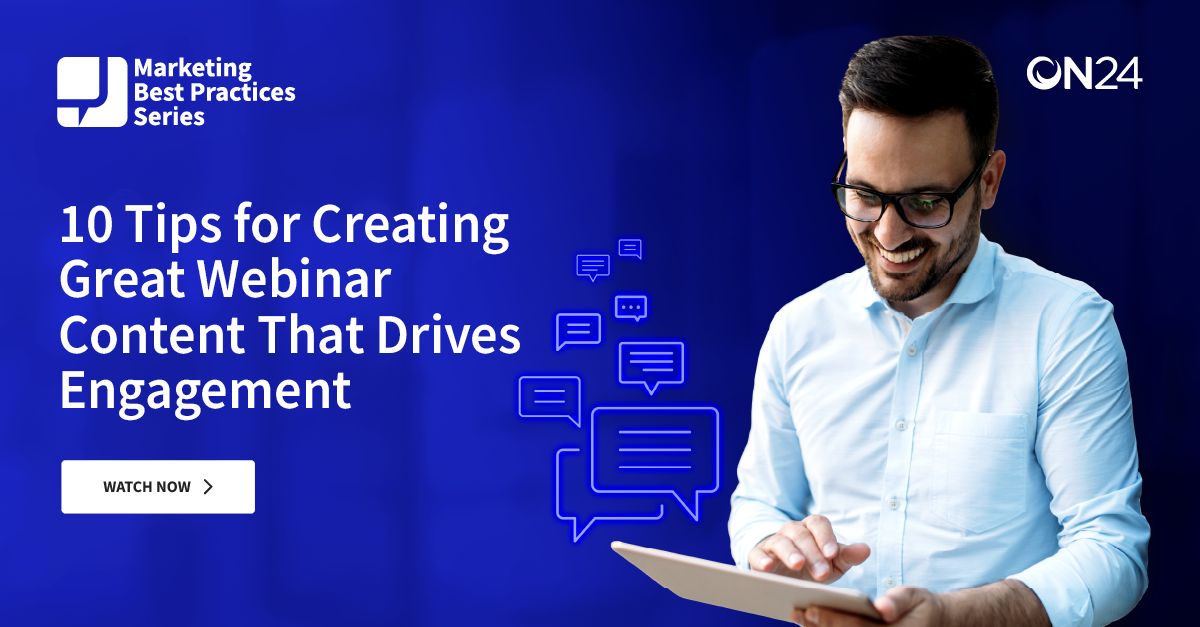What is a Webinar and How Do Webinars Work?

Webinars are one of the most indispensable weapons in a marketer’s armory. But what is a webinar and how does a webinar work?
There’s a lot going on behind the scenes of even the most basic webinar software. And, when it comes to a world-class solution like the ON24 Intelligent Engagement Platform, we rely on some of the best talent in the biz to make the experience of setting up and delivering a webinar seamless for you.
Webinars are different from meeting tools, which are designed to let small groups meet and collaborate in real time. They’re also different from traditional streaming media like videos, which don’t give the audience any way to engage with the content.
Webinar Definition
A webinar is an engaging online event where a speaker, or small group of speakers, delivers a presentation to a large audience who participate by submitting questions, responding to polls, and using other available interactive tools.
Webinars differ from meeting tools, designed to let small groups meet and collaborate in real time. They’re also different from traditional streaming media like videos, which don’t give the audience any way to engage with the content.
Learn more about webinars:
- Going Bigger: How to Promote Webinar Marketing Events
- Taking In-Person Events Digital? Five Things to Consider
- 11 Excellent Questions for your Post-Webinar Survey

Even the most bare-bones webinar has separate streams for slides and audio. But most modern webinars go far beyond that, with slides, presenter video, integrated social media and live attendee feedback in the form of questions, polls, idea storming and more.
Webinar basics — how to create a webinar

To produce the best webinar experience possible, follow these five basic steps:
-
- Define your audience.
- Brainstorm relevant topics.
- Create content — from slides to scripts — for your presentation.
- Practice your material and present it.
- Analyze webinar successes and failures.
How to prepare webinar content
The first step to preparing webinar content is understanding the audience you’re trying to reach. Are they early in the buying cycle? About to close? Are they already customers? If so, are they looking for educational content? Thought leadership? Once you know who you’re trying to reach, you can prepare your content.
Webinar content should be designed to keep a conversation going. Presentation slides should be light and easy to read. Presenters, too, should be the centerpiece and set the pace of the event. Finally, create opportunities for audience members to ask questions and participate in the webcast. Webinar content works best when it invites conversation.
Is a webinar always live?
No! Webinars can be live, simulive or on-demand. Each version has its own benefits to consider.
Live webinars allow you to engage your audience in real time and get instant analytics on that behavior. Simulive webinars let you record a webinar in advance and engage your audience in real-time — often through Q&A chat features — during the pre-recorded presentation. You can even roll over to a live presentation from simulive for further interaction and engagement.
On-demand webinars can be live-turned-on-demand events and pre-recorded on-demand webinars. Using on-demand gives your audience flexibility regarding when they consume your content. It also gives you, the presenter, more flexibility on providing a more polished experience.
ON24 webinar benchmarks

When is the best time to start promoting webinars?
According to our webinar benchmarks report, most attendees register either the week before the webinar launch (41%) or two weeks in advance (29%). Marketers should plan to start promotions over a three-week or longer time frame.
What is the average registration-to-attendee conversion rate?
Overall 53% of webinar registrants converted into an attendee. Of registrants, 35% converted as a live attendee and 23% converted as an on-demand attendee.
What’s the best day to send promotional emails?
In terms of driving registration, Monday (21.7%) and Tuesday (21.4%) are the best days to send promotional emails followed closely by Wednesday (20.1%).
How many attendees can I expect at my webinar?
The average number of webinar attendees in 2022 was 188.
How long should a webinar be?
Audiences engage with webinars for an average of 55 minutes.
Learn more essential webinar statistics
Download the ON24 2023 Digital Engagement Benchmarks and get a high-level look at the best practices that make webinars great. Download Now!
So what are the most important factors of webinar technology? Let’s take a look:
Making the webinar presenter successful

At ON24, we’ve spent years perfecting our presentation manager, PMXD. Obviously, we wanted to make it easy for you to upload, modify, manage and deliver your presentations. We quickly discovered that great webinar presentations take more than a well-uploaded presentation deck.
Most of our customers go into every webinar with at least two key players:
-
- The presenter delivers the webinar content.
- The producer handles all the behind-the-scenes work, like queuing video clips, managing guest speakers, and routing questions from webinar attendees.
Webinar tips for presenters
Before the webinar
Webinars have a lot of moving parts, so preparation is essential. Once you have a topic and an audience in mind, outline a presentation and draft slides. As you build your deck, look for opportunities to drive audience engagement through polls, surveys or Q&A.
Schedule a practice session with your finished deck, including anyone involved in the webinar — from presenters to producers and guests. Practicing identifies weak points and lets you adjust for better flow.
During the webinar
Start your webinars by guiding attendees through both the webinar console and the engagement tools included in the event. This way, attendees know how to interact with your event should they want to when prompted.
Run through your presentation as you normally would during your event, highlighting engagement opportunities (e.g., polls, surveys) as they arrive. If you’re running a Q&A session, your producer should select and prepare questions for the presenter to respond to.
After the webinar
Turn your live event into an on-demand webinar and email a link to your registrants and attendees within 48 hours of the event ending. Then, get creative.
Webinar tips for attendees

Before the webinar
As a webinar attendee, all you need to do is fill out a form to register for an event. Once registered, you should get an email with the details of an event, including a calendar invite.
Place the event on your work calendar and, on the day of the event, click the link to log in. Then, it’s just a matter of adjusting console windows as you see fit.
During the webinar
During the webinar, you’ll have the opportunity to interact with the host through engagement tools like Q&A, polls, surveys, certificates and downloadable resources. To access, or hide, these tools, simply click on the corresponding icon on the bottom row of the webinar console.
Other than that, sit back, relax and enjoy!
After the webinar
After the webinar ends, you should receive an email linking you to the on-demand version within a day or so. Click the link to enter the webinar.
We knew delivering live webinars can be stressful, so we helped the production team keep in touch with real-time chat and intuitive controls for controlling the webinar flow, pushing polls, and swapping out presentation content on the fly.
Providing an engaging webinar experience

Engagement is what makes the ON24 platform stand apart. And we take that very, very seriously.
When you’re asking people to stare at their computer screens for up to an hour you have to give them something interesting to stare at, it helps if you can also give them something interesting to do.
Most webinars these days include basics like a place to submit questions. But we don’t think that’s engaging enough. So, we’ve added to popular interactive tools like surveys, polls, downloadable assets, and integrated social media. We’ve also created more niche widgets like idea storming, testing and certification tools and group chat.
But that isn’t where it ends. We also built a robust suite of integrations to make sure the data collected through all that interactivity is passed to your marketing automation and CRM platforms, creating a seamless marketing data environment.
Treating always-on webinar audiences like live audiences

If you only consider the live audience, you aren’t taking the full picture into account. According to our Webinar Benchmarks Report, more than 40% of webinar attendees only sign up for the on-demand event.
That presents an interesting challenge for us on the back end of webinar software. How will we treat all those people who, for whatever reason, just couldn’t make it to the live event?
Sure, treating on-demand webinars like static videos would be easier, but then your audiences wouldn’t get the full webinar experience. When we think about webinar engagement, we always consider additional viewers who watch webinars on-demand or simulive (pre-recorded webinars, then broadcast to a live audience at a designated time).
Every ON24 webinar, no matter how it’s delivered or when it’s viewed, must have all the bi-directional interactivity of a live webinar, from moving windows around the console to the ability to submit questions — and get an answer.
Webinars have changed significantly over the past decade or so, and they’ll continue evolving as new technologies emerge. But for those of us who build the platform, the mission is always the same: to give you everything you need to engage an audience and meet your business goals.